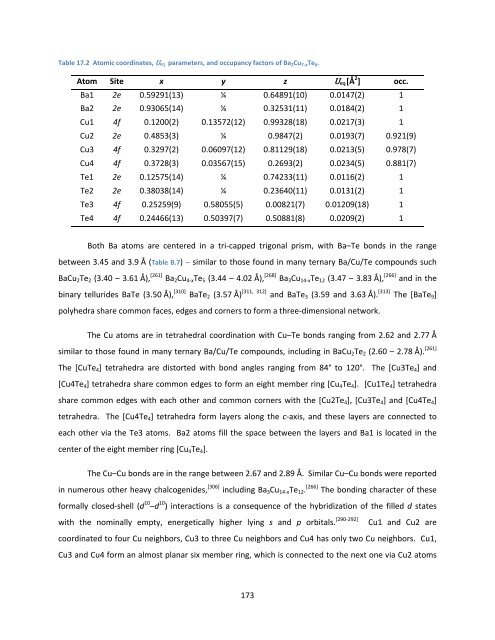Exploration and Optimization of Tellurium‐Based Thermoelectrics
Exploration and Optimization of Tellurium‐Based Thermoelectrics
Exploration and Optimization of Tellurium‐Based Thermoelectrics
You also want an ePaper? Increase the reach of your titles
YUMPU automatically turns print PDFs into web optimized ePapers that Google loves.
Table 17.2 Atomic coordinates, Ueq parameters, <strong>and</strong> occupancy factors <strong>of</strong> Ba 2Cu 7‐xTe 6.<br />
Atom Site x y z Ueq[Å 2 ] occ.<br />
Ba1 2e 0.59291(13) ¼ 0.64891(10) 0.0147(2) 1<br />
Ba2 2e 0.93065(14) ¼ 0.32531(11) 0.0184(2) 1<br />
Cu1 4f 0.1200(2) 0.13572(12) 0.99328(18) 0.0217(3) 1<br />
Cu2 2e 0.4853(3) ¼ 0.9847(2) 0.0193(7) 0.921(9)<br />
Cu3 4f 0.3297(2) 0.06097(12) 0.81129(18) 0.0213(5) 0.978(7)<br />
Cu4 4f 0.3728(3) 0.03567(15) 0.2693(2) 0.0234(5) 0.881(7)<br />
Te1 2e 0.12575(14) ¼ 0.74233(11) 0.0116(2) 1<br />
Te2 2e 0.38038(14) ¼ 0.23640(11) 0.0131(2) 1<br />
Te3 4f 0.25259(9) 0.58055(5) 0.00821(7) 0.01209(18) 1<br />
Te4 4f 0.24466(13) 0.50397(7) 0.50881(8) 0.0209(2) 1<br />
Both Ba atoms are centered in a tri‐capped trigonal prism, with Ba–Te bonds in the range<br />
between 3.45 <strong>and</strong> 3.9 Å (Table B.7) – similar to those found in many ternary Ba/Cu/Te compounds such<br />
BaCu2Te2 (3.40 – 3.61 Å), [261] Ba2Cu4‐xTe5 (3.44 – 4.02 Å), [268] Ba3Cu14‐xTe12 (3.47 – 3.83 Å), [266] <strong>and</strong> in the<br />
binary tellurides BaTe (3.50 Å), [310] BaTe2 (3.57 Å) [311, 312] <strong>and</strong> BaTe3 (3.59 <strong>and</strong> 3.63 Å). [313] The [BaTe9]<br />
polyhedra share common faces, edges <strong>and</strong> corners to form a three‐dimensional network.<br />
The Cu atoms are in tetrahedral coordination with Cu–Te bonds ranging from 2.62 <strong>and</strong> 2.77 Å<br />
similar to those found in many ternary Ba/Cu/Te compounds, including in BaCu2Te2 (2.60 – 2.78 Å). [261]<br />
The [CuTe4] tetrahedra are distorted with bond angles ranging from 84° to 120°. The [Cu3Te4] <strong>and</strong><br />
[Cu4Te4] tetrahedra share common edges to form an eight member ring [Cu4Te4]. [Cu1Te4] tetrahedra<br />
share common edges with each other <strong>and</strong> common corners with the [Cu2Te4], [Cu3Te4] <strong>and</strong> [Cu4Te4]<br />
tetrahedra. The [Cu4Te4] tetrahedra form layers along the c‐axis, <strong>and</strong> these layers are connected to<br />
each other via the Te3 atoms. Ba2 atoms fill the space between the layers <strong>and</strong> Ba1 is located in the<br />
center <strong>of</strong> the eight member ring [Cu4Te4].<br />
The Cu–Cu bonds are in the range between 2.67 <strong>and</strong> 2.89 Å. Similar Cu–Cu bonds were reported<br />
in numerous other heavy chalcogenides, [306] including Ba3Cu14‐xTe12. [266] The bonding character <strong>of</strong> these<br />
formally closed‐shell (d 10 –d 10 ) interactions is a consequence <strong>of</strong> the hybridization <strong>of</strong> the filled d states<br />
with the nominally empty, energetically higher lying s <strong>and</strong> p orbitals. [290‐292] Cu1 <strong>and</strong> Cu2 are<br />
coordinated to four Cu neighbors, Cu3 to three Cu neighbors <strong>and</strong> Cu4 has only two Cu neighbors. Cu1,<br />
Cu3 <strong>and</strong> Cu4 form an almost planar six member ring, which is connected to the next one via Cu2 atoms<br />
173
















